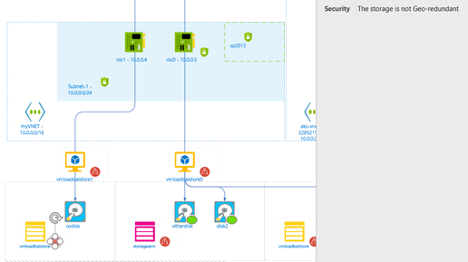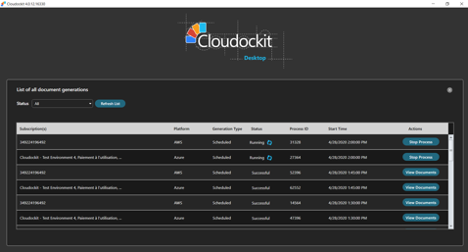We are changing bit how our release notes are structured to make it more exhaustive.
We will now mention a few highlighted new features and provide a complete list of new features and bug fixes at the end of the post.
Cloudockit v4.02 Highlighted features
Document Generation
- Cloudockit has a new template named Essential. This template is a way to generate reports for huge environments without generating huge documents. It contains only the first section (Settings) and an architecture diagram for all components
- During the document generation process, you will now get hints on how to improve your documents
Compliance Rules
- Compliance rules are now all selected by default to give you a better insight on the environments you are scanning. You can refine the rules you want to choose by only picking the ones you need.
- Furthermore, those rules are now displayed directly in the diagram where you now can see the components with issues

Azure
- Improved dependencies detection in App Services
- Logic Apps are now featuring rich diagrams to show dependencies:

AWS
- New workload added (AmazonPolicy)
GCP
- With the support of GCP Storage, we now support Track Changes in GCP: you will be able to compare your documents with previously generated documents and see the differences
- We now support to drop the document into a GCP Bucket:

Cloudockit Desktop
- Document generation is now isolated in different processes for better performances and tracking
- Offline activation can be done so that Cloudockit Desktop can be used without an internet connection
- Azure Managed Identity authentication is now supported (preview): you can install Cloudockit Desktop in an Azure Virtual Machine. It will give scan privileges directly to the Virtual Machines
- You can now see a complete history of the documents generated/running:

New features – Cloudockit Desktop
- Cloudockit Desktop now supports Offline Activation with no Internet Connectivity
- Cloudockit Desktop can now generate a Single Document for multiple subscriptions (previously, when you selected multiple subscriptions, multiple documents were generated)
- Cloudockit Desktop now supports Azure Managed Identity (https://docs.microsoft.com/en-us/azure/active-directory/managed-identities-azure-resources/overview) which means that you can give privileges to scan your Azure
- Subscriptions directly to the Azure Virtual Machines where Cloudockit Desktop is installed
- Cloudockit Desktop now gives you the ability to scan multiple GCP Projects and generate a single document that contains all the resources from the different projects
New features – Cloudockit
- Cloudockit API allows filtering on billing entries using JsonBillingDimension and JsonBillingType API Parameters
- Cloudockit API exposes AWS Billing by Tags, by using the IncludeBillingTags API Parameter
- Runtime & Languages are now displayed for Azure Functions
- Cloudockit now provides some hints about how to improve your Documents/Diagrams generation. The list of hints is available here: https://www.cloudockit.com/knowledge-base/document-generation-hints/
- Cloudockit Web UI now supports Notifications that will allow us to share some information with you like New Releases and Tips
- You can now generate Word documents that contain only the changes to your environment. This leverages the existing Cloudockit Track Changes features
- Visio Diagrams now features an icon near the shapes of resources that have been added or modified so that you can easily see how your environment evolves
- Cloudockit now supports the Track Changes features (Previously this feature was only available on AWS/Azure)
- Drop-off in Google Storage is now supported so you can use your own Google Cloud Storage to store your Reports/Diagrams
- Information retrieval in Cloudockit has been updated to better handle exceptions while scanning a component. For instance, if there was an issue (like lack of permissions) in scanning some particular settings like CORS Settings in a Storage Account, it could prevent the Storage Account from being shown. Now only the CORS Settings will be impacted
- Azure Template App Service section has been updated to show Architecture Diagram in the first section
- A new template named Essential is now available. This template contains the most important settings for each component but with less details than the Full template that can be too verbose for huge environments
- Cloudockit Web UI limit of time to generate a documentation has been changed from 6 hours to 24 hours and an email is now sent if this is not enough time to generate the document with some hints on how to fix it
- Names of documents generated have been updated to match Cloudockit Web Interface (for example, Azure Documentation has been renamed to Azure Word Report)
- Cloudockit now features an automatic mechanism to help produce documents for Huge Environments like automatically decreasing the amount of information displayed, the quality of the stencils, the split of documents…
- Diagrams of Virtual Networks in the Word document is now resized to fit the width of the page
- Cloudockit supports Azure Data Factory v2. Azure Data Factory v1 supports is under development
- Logic App complete diagrams are now included in the Cloudockit generated documents (diagrams/reports)
- Azure Storage API Version used by Cloudockit has been updated
- Audit has been renamed to Password Protected in the Cloudockit Website to avoid confusion. Password for protected documents are sent in a separate email than documents
- New Hint has been added to detect that you cannot get your Kubernetes Cluster details (Pods, Services…) because you lack permissions (https://cloudockit.com/knowledge-base/document-generation-hints/)
- JSON and LDIF files now features more Links between components as all collection of objects are now flagged as Links when appropriate
- All AWS API used by Cloudockit (Nuget Packages) have been updated
- All Google API used by Cloudockit (Nuget Packages) have been updated
- Azure Load Balancers are now scanned by Cloudockit even if they are not connected to any Virtual Machines or Virtual Machines ScaleSet
Bug Fixes
- Creating the Excel file for an Azure Subscription that is empty does not throw an exception anymore
- OneDrive Drop Off failed for big documents
- Diagrams Layout Optimization named Basic (still in preview) crashes for some layout
- AWS Secret Keys chars not masked in the Cloudockit Web UI in Trial mode
- Creation of a new Schedule displays a warning message despite the successful creation of the Schedule
- SQL Instances for Azure SQL Managed Instances not shown under some specific settings
- Unable to create a Document Generation Schedule with Additional Subscriptions
- Cloudockit Desktop cannot assume Role in EC2 Instance using Cross-Account role with a unique specified Region
- Cloudockit Desktop cannot scan All Environments (not individually selected) if Scheduling is used
- LDIF output billing section missing many Components Identifiers
- Excel reports are not displaying the Cost column
- Azure App Service Diagram is not displayed if the user who scans the environment has no permissions on the App Service Plan level
- Fixed Bugs: Generated documents in the Attachments tab (Report & Diagram)